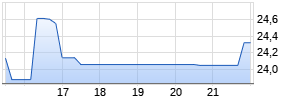
Sierra Bancorp Reports Earnings
PR Newswire
PORTERVILLE, Calif., April 24, 2017
PORTERVILLE, Calif., April 24, 2017 /PRNewswire/ -- Sierra Bancorp (Nasdaq: BSRR), parent of Bank of the Sierra, today announced its unaudited financial results for the quarter ended March 31, 2017. Sierra Bancorp recognized consolidated net income of $4.551 million for the first quarter of 2017, reflecting an increase of $515,000, or 13%, relative to the first quarter of 2016 for the following reasons: net interest income increased by 10% due primarily to a higher balance of interest-earning assets; non-interest income was up by 20%, due to in part to growth in our deposit account base and increased activity on commercial accounts; non-interest expense increased by 16%, with the majority of the increase coming from costs associated with our expanded branch network pursuant to our recent acquisition and de novo branch openings; and, our tax accrual rate was favorably impacted by new accounting guidance applied in the first quarter of 2017, related to incentive stock option exercises. For the first quarter of 2017 the Company's return on average assets was 0.94%, return on average equity was 8.85%, and diluted earnings per share were $0.32.

Total assets declined by $33 million, or 2%, during the first quarter of 2017, ending the period at $2.0 billion. The drop in assets resulted primarily from lower utilization on mortgage warehouse lines and a declining level of non-earning cash and balances due from banks, partially offset by strong organic growth in real estate loans and agricultural production loans and an increase in investment securities. Total nonperforming assets were reduced by $497,000, or 6%, during the first quarter, ending the period at slightly over $8 million. Deposits were up $25 million, or 1%.
"Vision without action is merely a dream. Action without vision just passes the time.
Vision with action can change the world." – Joel Barker
"Our bankers continue to focus on tangible results throughout all of our markets, with a commitment to provide our customers the very best banking experience possible," stated Kevin McPhaill, President and CEO. "While a market-driven reduction in mortgage warehouse balances resulted in a drop in total assets during the first quarter, it was the exceptional commitment of our team that led to strong organic growth in real estate and agricultural loans as well as a solid increase in core deposits," he added. "As a dynamic, growing community bank we recognize the importance of continuing to leverage our capital and enhance value for our shareholders, customers, employees and communities. This is a vision that has guided our actions for nearly four decades and continues to direct us today," concluded McPhaill.
Financial Highlights
As noted above, net income increased by $515,000, or 13%, in the first quarter of 2017 relative to the first quarter of 2016. Significant variances in the components of pre-tax income, including some items of a nonrecurring nature, are noted below.
Net interest income was up by $1.568 million, or 10%, for the quarter, due primarily to growth in average interest-earning assets totaling $205 million, or 13%, for the first quarter of 2017 over the first quarter of 2016. The increase in average earning assets came via organic growth, as well as our acquisition of Coast National Bank in mid-2016. The favorable impact of higher interest-earning assets was partially offset by a drop of six basis points in our net interest margin for the comparative quarters, which was caused primarily by lower investment yields and higher borrowing costs. The comparative results were also impacted by non-recurring interest income, which totaled $136,000 in the first quarter of 2017 relative to $42,000 in the first quarter of 2016. Non-recurring interest income is comprised of interest recoveries on non-accrual loans less any interest reversals for loans placed on non-accrual status, as well as penalties and accelerated fee recognition on loan prepayments.
Total non-interest income increased by $839,000, or 20%, for the quarterly comparison. The increase in non-interest income includes the following: a $200,000 increase in service charges on deposits, resulting from fees earned on a higher number of deposit accounts as well as increased revenue-generating activity on accounts; a $243,000 increase in bank-owned life insurance (BOLI) income, due primarily to higher income on BOLI associated with deferred compensation plans; and a $364,000 increase in other non-interest income, including a $248,000 increase in non-deposit service charges and fees as well as a $98,000 increase in dividends on restricted stock.
Total non-interest expense was up by $2.222 million, or 16%, for the first quarter of 2017 relative to the first quarter of 2016. The largest component of non-interest expense, salaries and benefits, increased by $1.020 million, or 15%, since salaries and benefits expense in the first quarter of 2017 includes expenses for former Coast employees retained subsequent to the acquisition in July of 2016, as well as staffing costs for our Sanger branch which opened in May of 2016 and our newest Bakersfield branch that commenced operations in March of 2017. The increase also includes salary adjustments in the normal course of business, and higher stock option expense related to options granted in February of 2017. Those increases were partially offset by a $236,000 increase in salaries directly related to successful loan originations, which are deferred and amortized as loan costs thus reducing current period compensation expense.
Occupancy expense increased by $570,000, or 33%, in the first quarter of 2017 over the first quarter of 2016, due to occupancy costs associated with the former Coast National Bank branches and our Sanger branch, higher rent and depreciation expense in other locations, and roughly $100,000 in non-recurring expenses associated with opening our newest Bakersfield branch in the first quarter of 2017. Other non-interest expense was up by $632,000, or 13%. This category includes recurring acquisition-related increases in various core operating expense categories including data processing, telecommunications, postage, and travel expense. It also reflects increases in the following areas: amortization expense on our core deposit intangible, which was up $73,000 for the quarter; directors' deferred compensation expense, in conjunction with the changes in BOLI income; stock option expense for directors; director retirement plan accruals, due to a non-recurring expense reversal of $173,000 in the first quarter of 2016; and, loan costs. Partially offsetting the increases were a $219,000 drop in acquisition costs, lower stationery and supply costs, and lower operations-related losses.
The Company's provision for income taxes was 28% of pre-tax income in the first quarter of 2017 compared to 34% in the first quarter of 2016. The lower tax accrual rate is primarily the result of our adoption of FASB's Accounting Standards Update 2016-09 effective January 1, 2017, and the subsequent change in accounting methodology associated with the disqualifying disposition of Company shares issued pursuant to the exercise of incentive stock options (ISOs). A disqualifying disposition is essentially an employee's sale, transfer, or exchange of ISO shares within two years of the date of grant or within one year of the option exercise leading to the issuance of such shares. Prior to January 1, 2017, the favorable tax impact of disqualifying dispositions was recorded directly to equity, whereas it is now reflected in the income statement as an adjustment to our income tax provision. The adoption of ASU 2016-09 will lead to volatility in our tax provision in future periods as the level of disqualifying dispositions fluctuates from quarter to quarter, and there were a relatively large number of such disqualifying transactions in the first quarter of 2017.
Balance sheet changes during the first quarter of 2017 include a reduction in total assets of $33 million, or 2%, due to lower loan and cash balances, partially offset by the purchase of investment securities. Cash balances were down $28 million, or 23%, including a $25 million reduction in non-earning balances due in large part to a lower level of cash items in process of collection. The $21 million increase in investment securities for the quarter resulted from the longer-term investment of some of the liquidity created by loan runoff.
Despite strong organic growth in real estate loans and agricultural production loans during the first quarter of 2017, gross loans were down $27 million, or 2%, due to lower utilization on mortgage warehouse lines. There was a $66 million reduction in outstanding balances on mortgage warehouse lines, as the utilization rate on those lines dropped to 26% at March 31, 2017 from 48% at December 31, 2016, due to lower residential refinancing and purchase activity. Agricultural real estate loans, on the other hand, reflect growth of $11 million, or 8%, other real estate loans increased by $30 million, or 4%, and agricultural production loans were up $3 million, or 7%. Despite a higher level of real-estate secured and agricultural production lending activity in recent periods, and a relatively robust pipeline of loans in process of approval, no assurance can be provided with regard to future loan growth as payoffs remain at relatively high levels and mortgage warehouse loan volumes are difficult to predict.
Total nonperforming assets, namely non-accrual loans and foreclosed assets, were reduced by $497,000, or 6%, during the first three months of 2017. The Company's ratio of nonperforming assets to loans plus foreclosed assets was 0.65% at March 31, 2017, compared to 0.68% at December 31, 2016. All of the Company's impaired assets are periodically reviewed, and are either well-reserved based on current loss expectations or are carried at the fair value of the underlying collateral, net of expected disposition costs. In addition to nonperforming assets, the Company had $14 million in loans classified as restructured troubled debt (TDRs) that were included with performing loans as of March 31, 2017, down slightly from the level of TDRs at December 31, 2016.
The Company's allowance for loan and lease losses was $9.6 million at March 31, 2017, down marginally from $9.7 million at December 31, 2016 due to the charge-off of certain impaired loan balances against previously-established reserves. Net loans charged off against the allowance totaled $113,000 in the first three months of 2017, compared to $393,000 in the first three months of 2016. Despite the drop in the level of the allowance it increased slightly as a percentage of loans, to 0.78% at March 31, 2017 from 0.77% at December 31, 2016, due to lower loan balances. It should be noted that our reserve level has been favorably impacted by acquired loans, which were booked at their fair value on the acquisition date and thus did not initially require a loan loss allowance. Furthermore, loss reserves allocated to mortgage warehouse loans are relatively low because we have not experienced any losses in that portfolio segment. Management's detailed analysis indicates that the Company's allowance for loan and lease losses should be sufficient to cover credit losses inherent in loan and lease balances outstanding as of March 31, 2017, but no assurance can be given that the Company will not experience substantial future losses relative to the size of the allowance.
Deposit balances reflect net growth of $25 million, or 1%, during the three months ended March 31, 2017, due in large part to continued organic growth in core non-maturity deposits. Junior subordinated debentures increased slightly from the accretion of the discount on trust-preferred securities acquired from Coast, but other borrowings were reduced by $64 million, or 87%, for the first quarter of 2017.
Total capital of $210 million at March 31, 2017 reflects an increase of almost $5 million, or 2%, for the year-to-date period, due to the addition of income and the impact of stock options exercised, net of dividends paid. There was also a slight reduction in our accumulated other comprehensive loss in the first quarter of 2017, which had a positive impact on capital. There were no share repurchases executed by the Company during the quarter.
About Sierra Bancorp
Sierra Bancorp is the holding company for Bank of the Sierra (www.bankofthesierra.com), which is in its 40th year of operations and is the largest independent bank headquartered in the South San Joaquin Valley. Bank of the Sierra is a community-centric regional bank, which offers a full range of retail and commercial banking services via 34 full-service branches located throughout California's South San Joaquin Valley and neighboring communities, on the Central Coast, and in Southern California locations including the Santa Clara Valley. We also maintain a loan production office and an online branch, and provide specialized lending services through an agricultural credit center, a real estate industries center, and an SBA center.
Forward-Looking Statements
The statements contained in this release that are not historical facts are forward-looking statements based on management's current expectations and beliefs concerning future developments and their potential effects on the Company. Readers are cautioned not to unduly rely on forward looking statements. Actual results may differ from those projected. These forward-looking statements involve risks and uncertainties including but not limited to the health of the national and local economies, the Company's ability to attract and retain skilled employees, customers' service expectations, the Company's ability to successfully deploy new technology, the success of acquisitions and branch expansion, changes in interest rates, loan portfolio performance, the Company's ability to secure buyers for foreclosed properties, and other factors detailed in the Company's SEC filings, including the "Risk Factors" and "Management's Discussion and Analysis of Financial Condition and Results of Operations" sections of the Company's most recent Form 10-K and Form 10-Q.
| PER SHARE DATA | ||||||
| (unaudited) | | Qtr Ended: | 1Q17 vs | Qtr Ended: | 1Q17 vs | |
| | | 3/31/2017 | 12/31/2016 | 4Q16 | 3/31/2016 | 1Q16 |
| Basic Earnings per Share | | $0.33 | $0.40 | -18% | $0.30 | +10% |
| Diluted Earnings per Share | | $0.32 | $0.40 | -20% | $0.30 | +7% |
| Common Dividends | | $0.14 | $0.12 | +17% | $0.12 | +17% |
| | | | | | | |
| Wtd. Avg. Shares Outstanding | | 13,801,635 | 13,779,671 | 0% | 13,265,371 | +4% |
| Wtd. Avg. Diluted Shares | | 14,009,496 | 13,931,472 | +1% | 13,386,652 | +5% |
| | | | | | | |
| Book Value per Basic Share (EOP) | | $15.21 | $14.94 | +2% | $14.64 | +4% |
| Tangible Book Value per Share (EOP) | | $14.42 | $14.14 | +2% | $14.05 | +3% |
| | | | | | | |
| Common Shares Outstanding (EOP) | | 13,829,649 | 13,776,589 | 0% | 13,275,888 | +4% |
| | | | | | | |
| KEY FINANCIAL RATIOS | | | | | | |
| (unaudited) | | Qtr Ended: | | Qtr Ended: | | |
| | | 3/31/2017 | 12/31/2016 | | 3/31/2016 | |
| Return on Average Equity | | 8.85% | 10.52% | | 8.41% | |
| Return on Average Assets | | 0.94% | 1.12% | | 0.93% | |
| Net Interest Margin (Tax-Equiv.) | | 3.90% Werbung Mehr Nachrichten zur Sierra Bancorp Aktie kostenlos abonnieren
E-Mail-Adresse
Bitte überprüfe deine die E-Mail-Adresse.
Benachrichtigungen von ARIVA.DE (Mit der Bestellung akzeptierst du die Datenschutzhinweise) -1  Vielen Dank, dass du dich für unseren Newsletter angemeldet hast. Du erhältst in Kürze eine E-Mail mit einem Aktivierungslink. Hinweis: ARIVA.DE veröffentlicht in dieser Rubrik Analysen, Kolumnen und Nachrichten aus verschiedenen Quellen. Die ARIVA.DE AG ist nicht verantwortlich für Inhalte, die erkennbar von Dritten in den „News“-Bereich dieser Webseite eingestellt worden sind, und macht sich diese nicht zu Eigen. Diese Inhalte sind insbesondere durch eine entsprechende „von“-Kennzeichnung unterhalb der Artikelüberschrift und/oder durch den Link „Um den vollständigen Artikel zu lesen, klicken Sie bitte hier.“ erkennbar; verantwortlich für diese Inhalte ist allein der genannte Dritte. Andere Nutzer interessierten sich auch für folgende News | ||||




